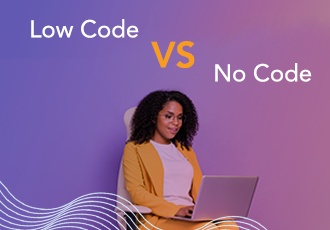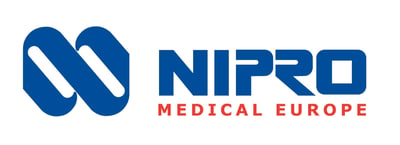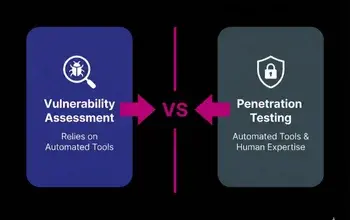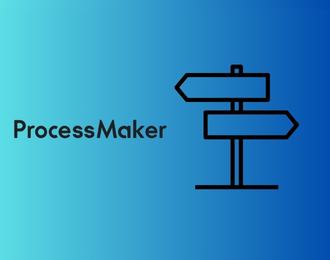For the past decade, lack of coding skill has been a barrier to digital progress. While digital initiatives have escalated for businesses, in-house IT skills remain in short supply. In a recent survey of 13,000 employers in the UK, Hays found that 94% faced a lack of tech talent, up from 89% the previous year. Despite this, digitalization efforts continue to grow.
The low code and no code movement aims to close this gap for businesses. Low and no code tools allow companies to keep pace with their competitors, deploy digital solutions at speed (and at a fraction of the cost), and experience the same or better outcomes. And business process automation software is a good example of where to start. But, as you can tell, we’ve already mentioned two similar concepts here: low code and no code. In this blog, we take a look at low code software vs. no code software, to discover which works best for you.
What is Digital Process Automation (DPA) Software?
Digital process automatiom software helps companies design, automate, and execute business activities and processes. It takes a granular approach to business processes, while keeping the big picture in mind long-term.
What are the Benefits of Digital Process Automation?
DPA Software is used worldwide, popular with companies that need to streamline their processes to achieve key goals. Here are some benefits:
Monitor Resource Utilization
The bigger the company, the more prone it is to organizational inefficiencies. DPA software brings transparency to workflows. It helps managers spot inefficiencies early and make the necessary changes. Resource time can be used more wisely.
.png?width=150&height=150&name=Untitled%20design%20(31).png) Increase Business Agility
Increase Business Agility
An organization with a strong digital infrastructure is usually better able to adapt to the modern world of work (sudden changes thanks to a pandemic or the ups and downs of the marketplace). Changes to workflows can be made easily, and the relevant people are notified automatically.
Improve Collaboration
With the right DPA software, collaboration is seamless. Siloed teams and data are removed, and new, immediate connections forged between different departments and stakeholders.
 Ensure Compliance
Ensure Compliance
For companies, a lack of compliance could mean financial penalties and/or significant damage to reputation. DPA software brings transparency to business processes, providing a background for audits and ensuring non-compliant activities are more easily flagged.
Cut Costs
DPA cuts costs company-wide thanks to less errors and process bottlenecks, enabling activities to be completed more quickly. Smoother collaboration allows for more efficient work and more time allows for better decision-making. Transparency over resources means making the most of what you have. Read more about the impact of business process automation here.
DPA Software: A Case Study
The marketing and HR departments of Nipro Europe Group Companies had a challenge when it came to sharing workflows across 26 different sites employing 3,500 people.
The Challenge:
There was so much information shared which led to documents getting lost or emails falling through the cracks. Even when Nipro Europe Group Companies went from paper to digital, each job site had different approaches. This meant that an email could contain a spreadsheet, word document or PDF.
The Solution:
Using FlowForma Process Automation, the teams created a workflow around Marketing Approval, a quality management process applied to the development of marketing collateral. Since the flow went ‘live’ in 2019, 416 marketing assets have passed through a process that involves 18 different steps. A dashboard was also created for stakeholders to instantly see the status of the approval process.
The Outcome:
Not only did the DPA software enable a fast and efficient way to fine-tune collateral, it created a documented history and audit trail to meet regulatory requirements. On a practical day-to-day basis, it has transformed the way people work.
“By standardizing processes, providing a single source of truth, and incorporating additional tasks in a uniform fashion, FlowForma Process Automation has helped our employees reduce their workloads,” Katherine Cox, Nipro Europe Group Companies.
Read The Nipro Europe Group Companies Case Study
Low code software vs no code software
So, low or no code? What’s the real difference? And what’s the right choice for you?
Low code requires some coding skill, and no code requires none at all.
A low code tool is usually implemented by IT professionals with some coding knowledge, while no-code alternatives offer businesses the same solution without the need for IT intervention. For SMBs and other businesses facing a lack of IT time and talent, no code evens out the playing field.
Onboarding/time to value:
|
|
No Code |
| Longer learning curve, with onboarding required. Still faster than traditional development options. | Less time to build, in comparison with low code. Processes can be live and self-sufficient within 4-6 weeks. |
IT Skill:
Low Code |
No Code |
| Coding is required, although IT’s involvement is still less than traditional from-scratch software solutions. Good for SMBs with a smaller IT team. | Minimal IT involvement required, and no coding whatsoever. Other business users can participate in development with the drag-and-drop functionality of no code tools. Good for small business owners, non-IT run businesses, or simply those without the IT resources to deploy new solutions. |
Cost:
Low Code |
No Code |
| More cost-effective than manual development due to less people, resources, and maintenance required. | The most cost-effective solution, designed specifically for businesses without a large IT infrastructure and budget. |
Getting buy in from C-level:
Low Code |
No Code |
| The resources, people, infrastructure, and time involved is less than traditional software development. Organizations use low code tools to move fast and meet business needs quickly. That low code solutions sit under the fold of IT teams ensures better governance. | Growing popularity amongst C-level executives. Since no code requires little or no intervention from IT teams, some C-suite executives question whether it creates parallel infrastructure that’s not as closely monitored as low code tools. Market-leading no code tools, like FlowForma’s, connect to over 500 applications, fully integrating workflows and reducing the risk of shadow IT. Connect FlowForma with hundreds of other systems. |
Scalability:
Low Code |
No Code |
| Offers flexibility and scalability, with the majority of low code applications able to scale a business process. | No code tools allow anyone in the business to drive digital change. This means rapid transformation across the entire organization. Solutions like FlowForma’s Business Process Automation software automates large-scale enterprise processes and workflows. |
Summary: Which Should Your Organization Choose?
When it comes to low/ no code there’s a lot of similarities. Both are a lower-cost alternative to traditional software solutions, incurring less time, talent, IT infrastructure, and maintenance. Businesses without IT strong power or knowhow should consider opting for a no code solution like FlowForma Process Automation.
Most low/ no code solutions are able to scale, and many integrate with third-party solutions – helping you to create a digital ecosystem that’s transparent and visible to all parties. With low code solutions, that sit under the fold of IT teams, there’s slightly less risk of shadow IT.
No code software is the most cost-effective solution. It also requires the least onboarding and has a fast time to value compared to other tools on the market.
Discover the benefits and ROI of no code.
No/Low Code is the Future of DPA Software
On a macro level, there is a widening gap between swift technological advancement and the IT talent needed to deploy new tools. For companies that want to scale and beat out competition, the gap between tools and talent can be a big problem.
No/low code DPA software is an alternative to traditional software development, with the solutions better able to address IT skills shortages and accelerations in technology. According to Gartner, the low and no code markets have seen steady growth due to their effectiveness in addressing some of the technology industry’s most complex challenges.
No/low code DPA software lets employees truly own their transformation projects. The technology is inclusive, and allows companies to digitize, innovate, and scale at speed.
DPA Automation with FlowForma Process Automation
FlowForma’s DPA software is celebrated and recommended by Forrester, G2, and more. Trusted by over 200,000 users, FlowForma helps businesses automate and manage business processes at speed and scale.
With FlowForma Process Automation, your business can:
• Digitalize processes in-house
• Drive cost savings
• Discover an ROI in 4-6 weeks
Explore how FlowForma customers rapidly achieve widespread process automation, serious savings, and better collaboration with FlowForma's award-winning tool.
.png) By
By 




